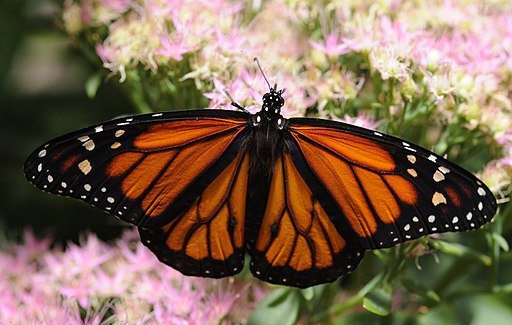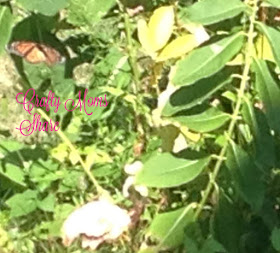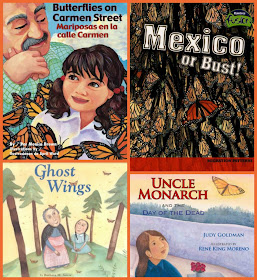As I mentioned yesterday this month's country for Global Learning for Kids is Mexico. Yesterday we explored art from Mexico. Since Hazel loves animals, I thought we would focus on an animal with a connection to Mexico and the perfect one is the monarch butterfly!
A few years ago we got some free milkweed seeds from Live Monarch and planted them in Hazel's garden. The milkweed keeps growing and this year I enjoyed watching a monarch butterfly lay her eggs.
Any time I moved closer she would fly away but she kept coming back and stayed around our milkweed for quite awhile. The monarch butterfly is like other butterflies. They start out as caterpillars. As caterpillars they eat milkweed leaves (as well as their own eggs). It molts its skin five times. The fifth time the chrysalis is under the skin. The chrysalis stage lasts for around ten days. Then the butterfly emerges. After its wings are dry the butterfly can fly. The butterflies will eat nectar and mate. Most monarch butterflies live about two to six weeks after metamorphosing into the butterfly. However the fourth generation each summer lives a longer life. The fourth generation are born in September and October and they live six to eight months! They also travel on a long migration to warmer climates for the winter. The monarchs migrate south and west from the United States and Canada. They winter in southern California and Mexico. If they come from east of the Rocky Mountains they will migrate to Mexico. For more information on monarch butterflies we took out some books and videos from our public library.
We did not read all of these books, but I did flip through them all and we loved the On the Wings of the Monarch DVD. One thing we found out is that many Mexicans believe that the butterflies are the souls of the dead family and/or children returning to be close to their families. The butterflies usually arrive around the Day of the Dead. We found a few books with stories about this belief.
The monarch butterflies migrate up to 2,500 miles to get to warmer weather for the winter and they return to the north because the milkweed plant cannot grow in their winter areas. For the return trip the monarchs use several generations to make it all the way to the farther north locations. Since the beginning generations only live for about a month or two they cannot make the entire trip. Yet we do not know how the fourth generation is able to live longer and make the trip down to Mexico and through the winter so their species survives each year.
 |
| Butterflies Chincua By AlejandroLinaresGarcia (Own work) [GFDL or CC BY-SA 4.0-3.0-2.5-2.0-1.0], via Wikimedia Commons |
So this has been our exploration of the amazing migrating monarch butterflies. They are threatened!! The things endangering them are the cutting of their favorite trees in the overwintering locations and the lack of milkweed. Many people do not enjoy having milkweed in their yards, but then they wonder where the monarchs have gone. There are reserves now in Mexico for the monarchs to overwinter including El Rosario in Orcampo, Sierra Chincua in Angangues, and Cerro Pelon. In February there is a Monarch Butterfly Festival in Angangues. Many people visit from the United States and Canada to see the wintering monarchs.
 |
| Thomas Bresson [CC BY 2.0], via Wikimedia Commons |
Sources for this post: Books & DVD pictured & Monarch Butterfly Site
Do you have any posts about Mexico? Perhaps a Mexican recipe, craft, lesson? Share it here. And visit all of these great posts shared to get a complete unit on Mexico.








No comments:
Post a Comment
I love to hear your comments and ideas. Thank you for reading and contributing!